KIA CERATO 2007 Manual PDF
Manufacturer: KIA, Model Year: 2007, Model line: CERATO, Model: KIA CERATO 2007Pages: 329, PDF Size: 34.09 MB
Page 71 of 329
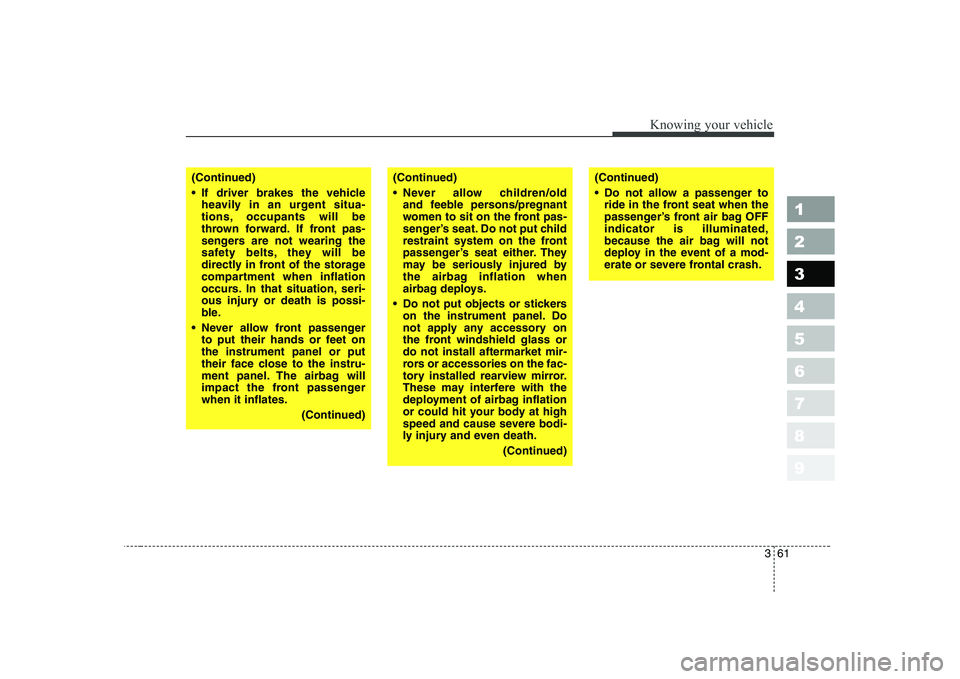
361
1 23456789
Knowing your vehicle
(Continued)
If driver brakes the vehicleheavily in an urgent situa-
tions, occupants will be
thrown forward. If front pas-
sengers are not wearing the
safety belts, they will be
directly in front of the storage
compartment when inflation
occurs. In that situation, seri-
ous injury or death is possi-
ble.
Never allow front passenger to put their hands or feet onthe instrument panel or put
their face close to the instru-
ment panel. The airbag will
impact the front passengerwhen it inflates.
(Continued)(Continued)
Never allow children/old and feeble persons/pregnant
women to sit on the front pas-
senger’s seat. Do not put child
restraint system on the front
passenger’s seat either. They
may be seriously injured by
the airbag inflation when
airbag deploys.
Do not put objects or stickers on the instrument panel. Do
not apply any accessory on
the front windshield glass ordo not install aftermarket mir-
rors or accessories on the fac-
tory installed rearview mirror.
These may interfere with the
deployment of airbag inflation
or could hit your body at high
speed and cause severe bodi-
ly injury and even death.
(Continued)(Continued)
Do not allow a passenger toride in the front seat when the
passenger’s front air bag OFFindicator is illuminated,
because the air bag will not
deploy in the event of a mod-
erate or severe frontal crash.
Page 72 of 329

Knowing your vehicle
62
3
1 23456789
Side airbag (if equipped) Side airbags are stored in the left
side of the driver’s seat and right side
of the front passenger’s seat. If airbag inflation conditions are met
(side collision), they will inflate. Curtain airbag (if equipped)
Curtain airbags are located along
both sides of the roof rails above the
front and rear doors.
They are designed to help protect the heads of the front seat occupantsand the rear outboard seat occupants
in certain side impact collisions.
WARNING
Do not use any accessory seat covers for the vehicle
equipped with side airbags.
Use of seat covers could inter-
fere with side airbag deploy-ment.
If seat or seat cover is dam-
aged, have the vehicle
checked and repaired by an
authorized Kia dealer. Inform
them that your vehicle is
equipped with side airbags.
Do not make modifications or additions to the seats. If seats
not allowed by Kia Motors are
used, unexpected injury mayresult in due to the malfunc-
tion of the airbag system.
1LDA2052
OUN0260911LDA2056
1LDA2050/1LDA2051
Page 73 of 329
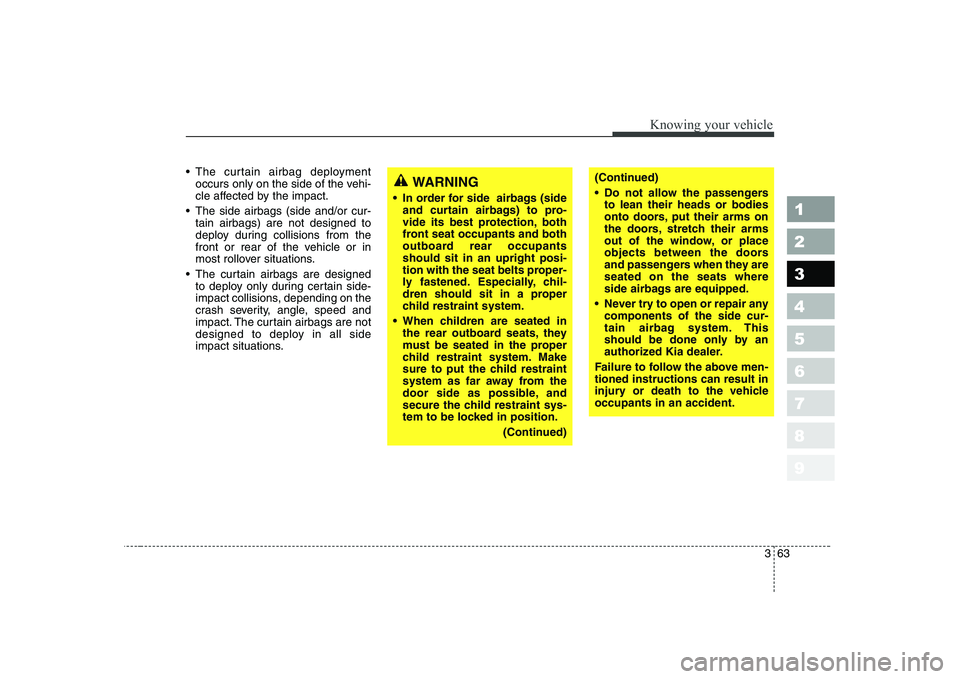
363
1 23456789
Knowing your vehicle
The curtain airbag deploymentoccurs only on the side of the vehi-
cle affected by the impact.
The side airbags (side and/or cur- tain airbags) are not designed to
deploy during collisions from the
front or rear of the vehicle or in
most rollover situations.
The curtain airbags are designed to deploy only during certain side-
impact collisions, depending on the
crash severity, angle, speed and
impact. The curtain airbags are not
designed to deploy in all side
impact situations.WARNING
In order for side airbags (side and curtain airbags) to pro-
vide its best protection, both
front seat occupants and both
outboard rear occupantsshould sit in an upright posi-
tion with the seat belts proper-
ly fastened. Especially, chil-
dren should sit in a proper
child restraint system.
When children are seated in the rear outboard seats, they
must be seated in the proper
child restraint system. Make
sure to put the child restraint
system as far away from the
door side as possible, and
secure the child restraint sys-
tem to be locked in position.
(Continued)(Continued)
Do not allow the passengersto lean their heads or bodies
onto doors, put their arms on
the doors, stretch their arms
out of the window, or place
objects between the doors
and passengers when they areseated on the seats where
side airbags are equipped.
Never try to open or repair any components of the side cur-
tain airbag system. This
should be done only by an
authorized Kia dealer.
Failure to follow the above men-tioned instructions can result in
injury or death to the vehicleoccupants in an accident.
Page 74 of 329

Knowing your vehicle
64
3
1 23456789
Why didn’t my airbag go off in a collision?
(Inflation and non-inflation condi-
tions of the airbag)
There are many types of accidents in
which the airbag would not be
expected to provide additional pro-tection.
These include rear impacts, second
or third collisions in multiple impact
accidents, as well as low speed
impacts. In other words, just because
your vehicle is damaged and even if
it is totally unusable, don’t be sur-
prised that the airbags did not inflate.
Airbag collision sensors
(1) SRS control module (with front impact sensor)
(2) Side impact sensor (if equipped)
OLD026058/1LDN2055/1LDA2054/1LDN2055A
12
Page 75 of 329

365
1 23456789
Knowing your vehicle
Airbag inflation condition
Front airbag
Front airbags (driver’s and front pas-
senger’s airbags) are designed to
inflate when the impact is deliveredto front collision sensors depending
on the intensity, speed or angles of
impact of the front collision - general-ly from an area a little to the left to a
little to the right of straight ahead.
WARNING
Do not hit or allow any objects to impact the locations where
airbag or sensors are installed.
This may cause unexpected
airbag deployment, whichcould result in serious per-
sonal injury or death.
If the installation location or angle of the sensors is altered
in any way, the airbags may
deploy when they should not
or they may not deploy when
they should, causing severe
injury or death.
Therefore, do not try to per-
form maintenance on or
around the airbag sensors.
Have the vehicle checked and
repaired by the authorized Kia
dealer.
(Continued)(Continued)
Problems may arise if the sen-sor installation angles are
changed due to the deforma-
tion of front bumper, body or
B, C pillar where side collision
sensors are installed. Have
the vehicle checked and
repaired by the authorized Kia
dealer.
Your vehicle has been designed to absorb impact
and deploy the airbag(s) in
certain collisions. Installing
aftermarket bumper guards or
replacing a bumper with non-
genuine parts may adversely
affect your vehicles collision
and airbag deployment per-
formance.
1LDA2059
Page 76 of 329

Knowing your vehicle
66
3
1 23456789
Side airbags (if equipped)
Side airbags (side and/or curtain airbags) are designed to inflate when
the impact is delivered to side colli-sion sensors depending on thestrength, speed or angles of impact
of side impact collision or rollover bythe side impact. Although the front airbags (driver’s
and front passenger’s airbags) aredesigned to inflate only in frontal col-
lision, it may inflate in any collision if
front impact sensors are delivered
with certain impact.
Side airbags (side and/or curtain airbags) are designed to inflate only
in side impact collision, it may inflate
in any collision if side impact sensors
are delivered with certain impact.
In other words, they may inflate inaccidents such as slant collision orimpact, collision or impact where the
front portion of the vehicle goes
under a vehicle with a higher ground
clearance (bus or truck), collision
with a utility pole or rollover.
Therefore, drive safely at all times.
If the vehicle chassis is impacted by
bumps or objects on unimproved
roads or sidewalks, airbags may
deploy. Drive carefully on unim-
proved roads or on surfaces not
designed for vehicle traffic.
To protect occupants, front airbags
or pre-tensioner seat belts may
deploy in certain side impact colli-
sions.
1JBA3514
OUN026090
Page 77 of 329
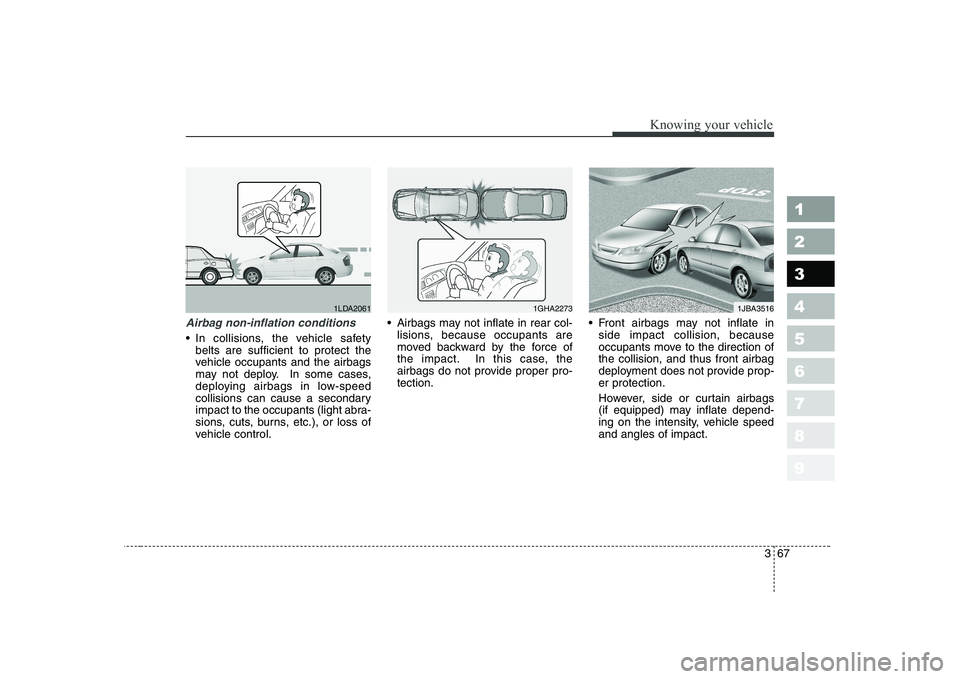
367
1 23456789
Knowing your vehicle
Airbag non-inflation conditions
In collisions, the vehicle safetybelts are sufficient to protect the
vehicle occupants and the airbags
may not deploy. In some cases,
deploying airbags in low-speed
collisions can cause a secondary
impact to the occupants (light abra-
sions, cuts, burns, etc.), or loss of
vehicle control. Airbags may not inflate in rear col-
lisions, because occupants are
moved backward by the force of
the impact. In this case, the
airbags do not provide proper pro-tection. Front airbags may not inflate in
side impact collision, because
occupants move to the direction ofthe collision, and thus front airbag
deployment does not provide prop-er protection.
However, side or curtain airbags
(if equipped) may inflate depend-
ing on the intensity, vehicle speedand angles of impact.
1GHA22731LDA20611JBA3516
Page 78 of 329
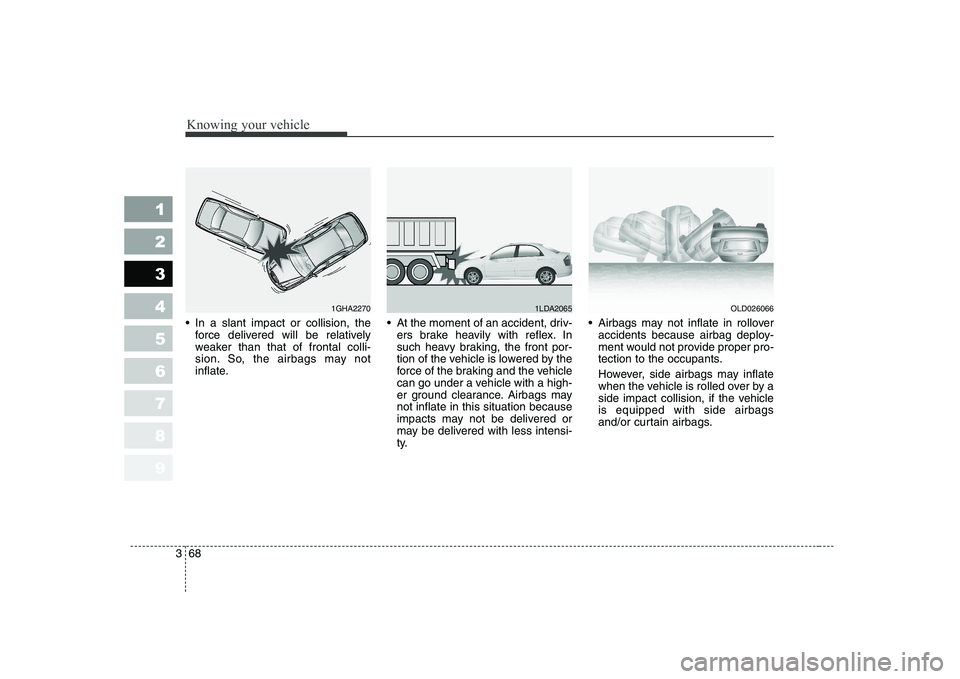
Knowing your vehicle
68
3
1 23456789
In a slant impact or collision, the
force delivered will be relatively
weaker than that of frontal colli-
sion. So, the airbags may not
inflate. At the moment of an accident, driv-
ers brake heavily with reflex. In
such heavy braking, the front por-
tion of the vehicle is lowered by the
force of the braking and the vehicle
can go under a vehicle with a high-
er ground clearance. Airbags maynot inflate in this situation because
impacts may not be delivered or
may be delivered with less intensi-
ty. Airbags may not inflate in rollover
accidents because airbag deploy-
ment would not provide proper pro-
tection to the occupants.
However, side airbags may inflate when the vehicle is rolled over by a
side impact collision, if the vehicleis equipped with side airbags
and/or curtain airbags.
1GHA22701LDA2065OLD026066
Page 79 of 329

369
1 23456789
Knowing your vehicle
Airbags may not inflate if the vehi-cle collides with objects such as
utility poles or trees, where the
point of impact is concentrated to
one area and the full force of the
impact is not delivered to the sen-
sors. How does the airbag system operate
Airbag only operates when the
ignition switch is turned to ON or
START position.
Airbags inflate instantly in the event of serious frontal or side col-lision (if equipped with side airbag
or curtain airbag) in order to help
protect the occupants from serious
physical injury.
There is no single speed at which the airbags will inflate.
Generally, airbags are designed to
inflate by the severity of a collision
and its direction. These two factors
determine whether the sensors
send out an electronic deploy-ment/inflation signal. Airbag deployment depends on a
number of factors including vehiclespeed, angles of impact and the
density and stiffness of the vehi-
cles or objects which your vehicle
hits in the collision. Though, factorsare not limited to those mentioned
above.
The front airbags will completely inflate and deflate in an instant.
It is virtually impossible for you to
see the airbags inflate during an
accident. It is much more likely that
you will simply see the deflatedairbags hanging out of their stor-
age compartments after the colli-sion.
1JBA3518
Page 80 of 329
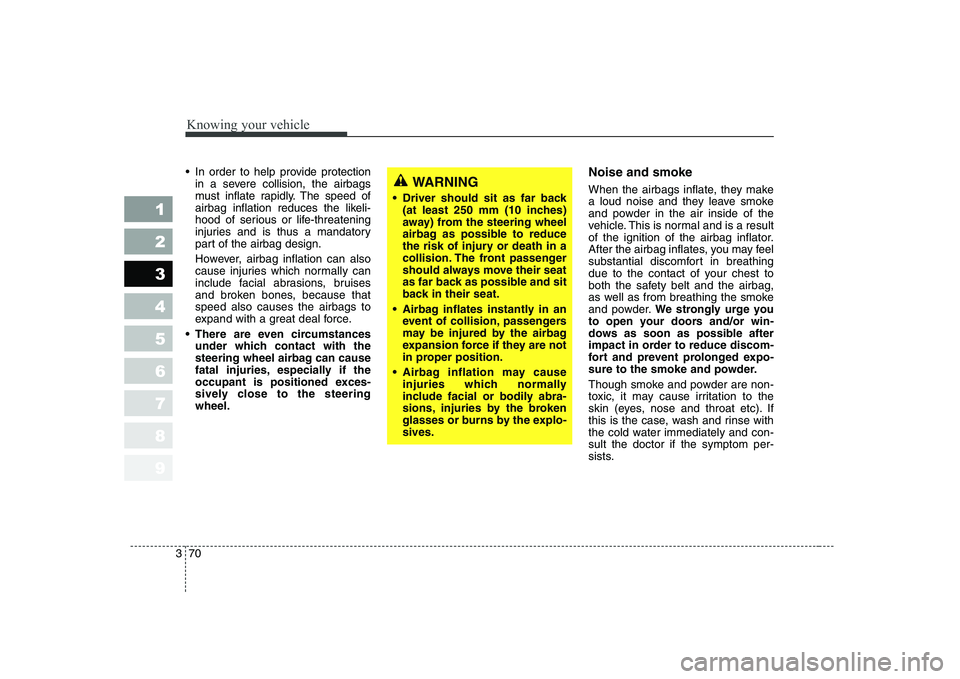
Knowing your vehicle
70
3
1 23456789
In order to help provide protection
in a severe collision, the airbags
must inflate rapidly. The speed ofairbag inflation reduces the likeli-
hood of serious or life-threatening
injuries and is thus a mandatory
part of the airbag design.
However, airbag inflation can also
cause injuries which normally can
include facial abrasions, bruises
and broken bones, because thatspeed also causes the airbags to
expand with a great deal force.
There are even circumstances under which contact with the
steering wheel airbag can cause
fatal injuries, especially if the
occupant is positioned exces-
sively close to the steeringwheel. Noise and smoke
When the airbags inflate, they make
a loud noise and they leave smoke
and powder in the air inside of the
vehicle. This is normal and is a result
of the ignition of the airbag inflator.
After the airbag inflates, you may feel
substantial discomfort in breathing
due to the contact of your chest to
both the safety belt and the airbag,
as well as from breathing the smoke
and powder.
We strongly urge you
to open your doors and/or win-
dows as soon as possible after
impact in order to reduce discom-
fort and prevent prolonged expo-
sure to the smoke and powder.
Though smoke and powder are non-
toxic, it may cause irritation to the
skin (eyes, nose and throat etc). If
this is the case, wash and rinse with
the cold water immediately and con-sult the doctor if the symptom per-
sists.WARNING
Driver should sit as far back (at least 250 mm (10 inches)
away) from the steering wheel
airbag as possible to reduce
the risk of injury or death in a
collision. The front passenger
should always move their seat
as far back as possible and sit
back in their seat.
Airbag inflates instantly in an event of collision, passengers
may be injured by the airbag
expansion force if they are not
in proper position.
Airbag inflation may cause injuries which normally
include facial or bodily abra-
sions, injuries by the broken
glasses or burns by the explo-sives.